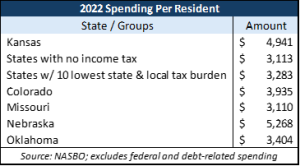Kansas is spending too much and needs to reform the way it creates the yearly budget, was the message Dr. Vance Ginn — a senior fellow at the Kansas Policy Institute, told a state legislature committee on Oct. 2, 2024.
The Sentinel is owned by KPI.

Ginn, who was also the former chief economist in the White House Office of Management and Budget and is president of Ginn Economic Consulting, told the Special Committee on Budget Process and Development the “main problem of government” is how much is spent.
“Unfortunately, in Kansas, there’s too much that’s being spent,” he said. “I know that’s why you’re looking at budget process reforms and how to spend less over time to make sure that you have the best use of taxpayer money that’s coming out of the productive private sector.”
Ginn pointed to Colorado as a good example.
“When you look at Colorado, which has (gone) from red to purple to blue over time, one of the things that’s helped them to restrain spending, no matter what the political situation has been, is their Taxpayer Bill of Rights,” Ginn said. “TABOR, as it’s called, is a spending limit that limits the growth of the budget to no more than population growth plus inflation, which is a good measure of the average taxpayer’s ability to pay for government spending.
“Now it’s been weakened a little bit over time by some courts and by politicians and things of that nature, but it still has been able to hold their spending to population and inflation and keep taxes down lower than it otherwise would be.”
Ginn noted that other countries are doing something similar as well.
“We’ve also seen spending limits work in other countries. Sweden and others. The Swiss debt break is another example of that, ” he said. “So it’s not just the states, which I think is important, as we’re talking about here in Kansas today, but also to look at what other countries have done.”
Ginn also suggested looking at a longer-term budget — if perhaps not as long as the federal government’s 10-year budget projections.
“I don’t know how far in advance you want to go, but maybe a couple of years, two or three years, I think looks good to figure out what’s happening for the future,” he said. “How are the trends looking for different areas of the budget, whether you look at health care, education, transportation, I think those things are really important. It’s something that’s been able to work in Florida to help to restrain the spending over time.”
Ginn suggested other measures as well, including independent efficiency audits, such as Texas uses, to help find waste within state departments.
He also said the state should look at an annual budget analysis.
“So you have the budget that’s passed, but then look at it throughout each year to ensure that those dollars are being spent wisely and that we’re getting the effectiveness — the intended goals are being met for each one of these programs as well,” he said.
Ginn is also an advocate of “zero-based” and “priority-based budgeting,” as well.
“I think it is really important to adopt priority-based budgeting,” Ginn said. “Zero-based budgeting is important. Start from scratch and build your way up. It’s kind of costly, it’s time consuming to do some of those things. But there’s also performance-based budgeting to make sure that you’re getting the performance out of these. So a combination of those is priority-based budgeting, which I think, if you’re looking at the annual reviews, would be a great opportunity for you all to make some suggestions, make some changes.”
 Kansas spent $4,941 per resident in 2022, excluding federal and debt-related spending, as reported by the National Association of State Budget Officers. By comparison, Colorado spent $3,935 per resident. Missouri ($3,110) and Oklahoma ($3,404) also spent a lot less per resident to provide the same services as Kansas. Only Nebraska spent more, at $5,268 per resident.
Kansas spent $4,941 per resident in 2022, excluding federal and debt-related spending, as reported by the National Association of State Budget Officers. By comparison, Colorado spent $3,935 per resident. Missouri ($3,110) and Oklahoma ($3,404) also spent a lot less per resident to provide the same services as Kansas. Only Nebraska spent more, at $5,268 per resident.
Just getting to Colorado’s level of efficiency would save taxpayers almost $3 billion annually.
Responsible Kansas Budget would meet many of Ginn’s suggestions
Ginn pushed something KPI has proposed for two years now.
“The Responsible Kansas Budget” is a model to achieve a sustainable budget through tax-and-expenditure limits based on transparency and performance-based budgeting, which will rein in government spending to avoid deficits.
In 2022, KPI released its first edition of the Responsible Kansas Budget for 2023. The model proposed a limit on All Funds (state funds plus federal funds) appropriations in 2023 at $21.0 billion based on limiting spending increases to the combined rate of population growth and inflation. Instead, the Legislature approved an All-Funds budget of $22.9 billion—nearly $2 billion more than the RKB.
The RKB uses a simple calculation of finding the growth rate of the state’s resident population and adding it to the growth rate of the state’s Consumer Price Index [a common measure of inflation] to set maximum appropriation limits.
Indeed, from fiscal 2005, through fiscal 2023, state appropriations grew from $7.2 billion to 17.1 billion.
Had the RKB’s appropriation limits been in place, the growth would have been to “only” $11.4 billion, saving Kansas taxpayers roughly $5.7 billion.



